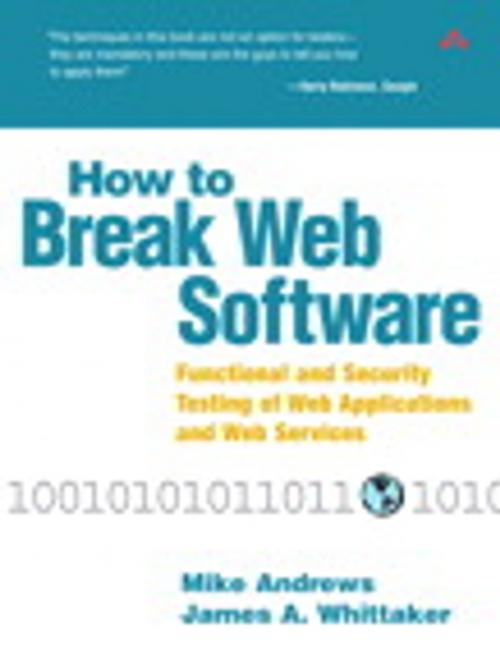How to Break Web Software
Functional and Security Testing of Web Applications and Web Services
Nonfiction, Computers, Networking & Communications, Computer Security, Operating Systems, Application Software| Author: | Mike Andrews, James A. Whittaker | ISBN: | 9780321657510 |
| Publisher: | Pearson Education | Publication: | February 2, 2006 |
| Imprint: | Addison-Wesley Professional | Language: | English |
| Author: | Mike Andrews, James A. Whittaker |
| ISBN: | 9780321657510 |
| Publisher: | Pearson Education |
| Publication: | February 2, 2006 |
| Imprint: | Addison-Wesley Professional |
| Language: | English |
"The techniques in this book are not an option for testers—they are mandatory and these are the guys to tell you how to apply them!"
—HarryRobinson, Google.
Rigorously test and improve the security of all your Web software!
It’s as certain as death and taxes: hackers will mercilessly attack your Web sites, applications, and services. If you’re vulnerable, you’d better discover these attacks yourself, before the black hats do. Now, there’s a definitive, hands-on guide to security-testing any Web-based software: How to Break Web Software.
In this book, two renowned experts address every category of Web software exploit: attacks on clients, servers, state, user inputs, and more. You’ll master powerful attack tools and techniques as you uncover dozens of crucial, widely exploited flaws in Web architecture and coding. The authors reveal where to look for potential threats and attack vectors, how to rigorously test for each of them, and how to mitigate the problems you find. Coverage includes
· Client vulnerabilities, including attacks on client-side validation
· State-based attacks: hidden fields, CGI parameters, cookie poisoning, URL jumping, and session hijacking
· Attacks on user-supplied inputs: cross-site scripting, SQL injection, and directory traversal
· Language- and technology-based attacks: buffer overflows, canonicalization, and NULL string attacks
· Server attacks: SQL Injection with stored procedures, command injection, and server fingerprinting
· Cryptography, privacy, and attacks on Web services
Your Web software is mission-critical—it can’t be compromised. Whether you’re a developer, tester, QA specialist, or IT manager, this book will help you protect that software—systematically.
"The techniques in this book are not an option for testers—they are mandatory and these are the guys to tell you how to apply them!"
—HarryRobinson, Google.
Rigorously test and improve the security of all your Web software!
It’s as certain as death and taxes: hackers will mercilessly attack your Web sites, applications, and services. If you’re vulnerable, you’d better discover these attacks yourself, before the black hats do. Now, there’s a definitive, hands-on guide to security-testing any Web-based software: How to Break Web Software.
In this book, two renowned experts address every category of Web software exploit: attacks on clients, servers, state, user inputs, and more. You’ll master powerful attack tools and techniques as you uncover dozens of crucial, widely exploited flaws in Web architecture and coding. The authors reveal where to look for potential threats and attack vectors, how to rigorously test for each of them, and how to mitigate the problems you find. Coverage includes
· Client vulnerabilities, including attacks on client-side validation
· State-based attacks: hidden fields, CGI parameters, cookie poisoning, URL jumping, and session hijacking
· Attacks on user-supplied inputs: cross-site scripting, SQL injection, and directory traversal
· Language- and technology-based attacks: buffer overflows, canonicalization, and NULL string attacks
· Server attacks: SQL Injection with stored procedures, command injection, and server fingerprinting
· Cryptography, privacy, and attacks on Web services
Your Web software is mission-critical—it can’t be compromised. Whether you’re a developer, tester, QA specialist, or IT manager, this book will help you protect that software—systematically.















